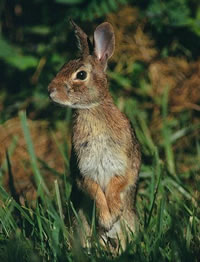
By Joe Phipps, Staff Writer
During the most recent volunteer day at Funks Grove, our goal for the day was to spread seeds from native prairie plants. Since the chore consisted of emptying a garbage can full of seeds throughout a prairie plot that had just experienced heavy rainfall, any feelings of excitement were lost on me.
In an attempt to pass the time in the damp prairie, I let my eyes wander wherever curiosity took them and I noticed a trending occurance out in the field many may simply overlook: rabbit pellets.
Every few dozen yards there were piles of rabbit pellets, yet there were no rabbits. While spreading the seeds, I let thoughts of rabbits consume me, but I quickly realized what I knew about rabbits was not enough to be any sort of authority on the small mammal.
Rabbits are one of the most common mammals in our region, but how much do we really know about them? My desire to learn more about rabbits, as well as my desire for everyone to learn more about rabbits, has resulted in a whole week dedicated to them.
The most common rabbit in central Illinois, as well as most of the eastern United States, is the Eastern Cottontail (Sylvilagus floridanus). While many people would compare rabbits to rodents, they actually belong to an order of mammals known as lagomorphs. Lagomorphs are evolutionarily distant from rodents and only bare a superficial resemblance.
Key features that separate these animals from rodents is their four upper biting teeth and almost wholly vegetarian diet. True rodents, on the other hand, have only two upper biting teeth and will often eat meat when scavenging.
While we see these rabbits feeding on campus in the evenings, they choose to remain primarily inactive during the day. The average Eastern Cottontail lives anywhere between six months and a year, during which the female rabbits can have up to seven litters consisting of up to twelve young, known as kits.
February typically marks the beginning of the breeding season in Illinois, and according to Dr. Given Harper of the IWU biology department, the mating behavior of the rabbits can be observed when the pair engages in a mating dance.
Despite their cuteness being almost a natural defense, Eastern Cottontails face a number of problems that we may often observe. The biggest threat to these rabbits is the variety of predators hunting them. Domesticated dogs and cats will often kill rabbits, but so will hawks, owls, raccoons and even crows.
Dr. Harper also testified to an alarming experience. He heard the scuffling of fighting animals while in his garage and looked out to see two crows capturing a rabbit and taking it into a tree.
Another unusual problem that Cottontails face is with their food. Having compact bodies, their digestive systems aren’t long enough to digest the fibrous, low-nutrient foods they consume.
The way they compensate for not having the ruminant digestive systems seen in cows is that they often pass partially digested food as “cecotropes,” and then immediate eat them in a process known as “coprophagy.”
By eating their partially digested feces, they can fully extract important vitamins and nutrients from their foods. After the food is fully digested the second time around, it is deposited in piles of small black pellets.
And it was a mound of these small black pellets that spiked my curiosity about the Cottontail rabbits, which inhabit not only our suburbs and parks, but also our forests and prairies.
Despite being out in the damp prairie spreading seeds, the thought of rabbits and how they interact with their surroundings brought a little bit of happiness into my dreary Saturday. And little did I know that the pellets I had associated with rabbits would also be one of the most interesting processes that I would forever associate with Cottontails.
